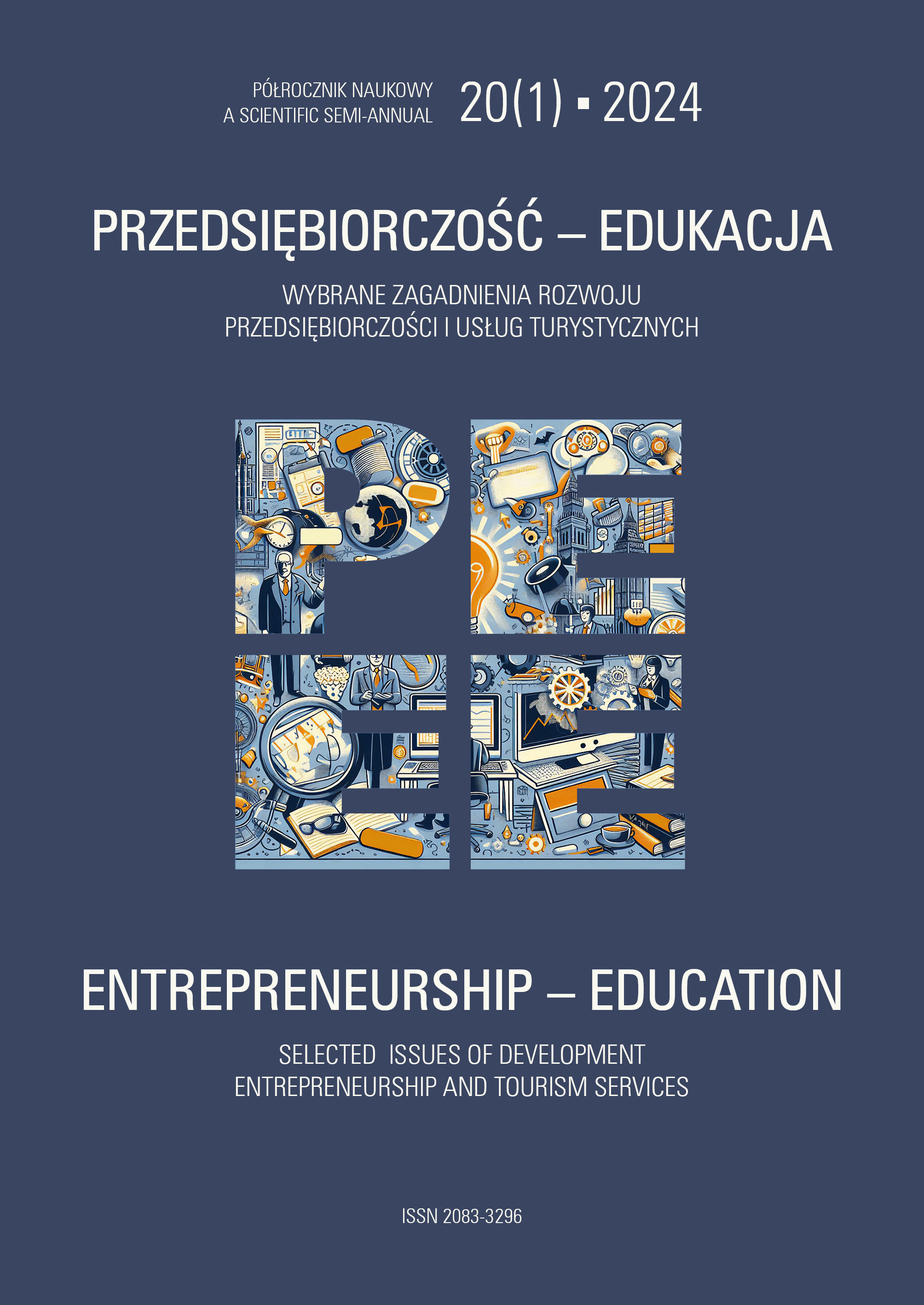Conditions and Opportunities for Selected Forms of Tourism in the Sinai Peninsula
DOI:
https://doi.org/10.24917/20833296.201.11Keywords:
Egypt, Red Sea, tourism, SinaiAbstract
The aim of this article is to present the Sinai Peninsula as a place for opportunities for selected forms of tourism with a particular emphasis on religious, qualified (active), nature, leisure and business tourism. In order to achieve this aim, a literature review, a comparative analysis, a SWOT analysis and
the construction of a model by the authors were used to illustrate the links between the various forms of tourism in the Sinai Peninsula. The research indicated which elements of the SWOT analysis are most important for the development of tourism and what links exist between the various forms of tourism in the area. The authors found that there are no common elements between religious and business tourism, while for other cases connections can be found each time. Particular attention was paid to leisure tourism, qualified tourism and nature tourism, as they are strongly linked and correlate with each other. Although nature tourism had the lowest frequency on the basis of the survey, it was found to be distinguished by the multiplicity of locations, as well as diversity in terms of terrain and the uniqueness of rock formations on a global scale.
References
Adamski, P., Ciapała, S. (2016). Turystyka przyrodnicza, ekoturystyka i turystyka zrównoważona–Problemy klasyfikacyjne. Folia Turistica, 40, 9‒26.
Abdennour, S. (2007). Egyptian customs and festivals (Vol. 3). Oxford University Press.
Ayoub, M. (2018). Medical tourism in Egypt: Opportunities and challenges. Master’s Thesis, the American University in Cairo. AUC Knowledge Fountain.
Bartosik, A. (2005). Katowice jako centrum turystyki biznesowej. Dziedzictwo przemysłowe jako atrakcyjny produkt dla turystyki i rekreacji. Doświadczenia krajowe i zagraniczne. Katowice: Górnośląska Wyższa Szkoła Handlowa.
Bończak, B. (2013). Aktywne formy turystyki – problemy terminologiczne. Warsztaty z Geografii Turyzmu, 3,49‒62.
Borodako, K., Berbeka, J., Rudnicki, M. (2014). Usługi specjalistyczne w turystyce biznesowej. Fundacja Uniwersytetu Ekonomicznego.
Davidson, R., Cope, B. (2003) Turystyka biznesowa. Konferencje, podróże motywacyjne, wystawy, turystyka korporacyjna. Warszawa: POT.
Galal, N. (1999). Studies on the coastal ecology and management of the Nabq Protected Area, South Sinai, Egypt. Doctoral dissertation, University of York.
Goldschmidt, A. (2008). A Brief History of Egypt. New York: Infobase Publishing.
Gouda, E.A.S. (2012). Problems that impede sustainable tourism development in Egypt. International Journal of Social, Behavioral, Educational, Economic, Business and Industrial Engineering, 6(110),2800.
Gryszel, P. (2016). Współczesne krajoznawstwo – renesans czy moda? Od modelu 3S do modelu 4H. Współczesne Oblicza Krajoznawstwa, 67‒84
Hołowiecka, B., Grzelak‑Kostulska, E. (2013). Turystyka i aktywny wypoczynek jako element stylu życia seniorów. Acta Universitatis Lodziensis. Folia Oeconomica, 291, 163‒172.
Jackowski, A. (1998). Pielgrzymki = turystyka pielgrzymkowa = turystyka religijna? Rozważania terminologiczne. Turyzm, 8(1), 5‒11.
Jackowski, A. (2003). Święta przestrzeń świata: podstawy geografii religii. Kraków: Wydawnictwo Uniwersytetu Jagiellońskiego.
Jędrusik, M., Makowski, J., Plit, F. (2010). Geografia turystyczna świata. Nowe trendy. Regiony turystyczne. Warszawa: Wydawnictwo Uniwersytetu Warszawskiego.
Kosytorz, R. (2013). Synaj górą objawienia Imienia Boga. Scriptura Sacra, 17, 169‒180.
Korba, E., Iwan, B. (2012). Nurkowanie jako rodzaj turystyki kwalifikowanej. Zeszyty Naukowe. Turystyka i Rekreacja, 1(9), 21‒44.
Łobożewicz, T., 1983, Turystyka kwalifikowana. Warszawa: Wydawnictwo PTTK „Kraj”.
Marciniak, M., Dłużewska, A.M. (2015). Wpływ Wiosny Arabskiej na turystykę w Egipcie. Turystyka kulturowa, 9, 38‒53.
Mika, M. (2007). Turystyka przyrodnicza: jej istota i współczesne kierunki rozwoju. Studia nad turystyką. Tradycje, stan obecny i perspektywy badawcze, 311‒320.
Mokras‑Grabowska, J. (2015). Turystyka aktywna–zagadnienia terminologiczne i klasyfikacje. Wczoraj, dziś i jutro turystyki aktywnej i specjalistycznej, 11‒20.
Mumford, G.D. (2013). Serabit el‐Khadim. The Encyclopedia of Ancient History.
Richter, T., Steiner, C. (2007). Sectoral transformations in neo‑patrimonial rentier states: tourism development and state policy in Egypt. GIGA Working Papers, 61, 13‒25.
Różycki, P. (2009). Perspektywy rozwoju turystyki pielgrzymkowej, religijnej i kulturowej na terenie Polski i w Europie. Turystyka Kulturowa, 12, 47‒56.
Różycki, P. (2010). Geoturystyka i turystyka industrialna na tle nowoczesnych form turystyki. Geoturystyka, 3‒4.
Russell, M.L. (2013). Egypt. ABC‑CLIO. California: Santa Barbara.
Szałata, Ł., Zwoździak, J. (2011). Analiza SWOT jako podstawowe narzędzie w zarządzaniu środowiskiem. Rocznik Ochrona Środowiska, 13, 1105‒110.
Zdziebłowski, S. (2015). Egipt. Gliwice: Wydawnictwo Helion.
Ziółkowska‑Weiss,K. (2012). Podróże motywacyjne a rozwój przedsiębiorczości w firmie na przykładzie niemieckiej i hiszpańskiej grupy pracowników. Przedsiębiorczość ‒ Edukacja [Entrepreneurship – Education], 8, 396‒398.
Ziółkowska‑Weiss, K. (2016). Zachowania konsumenckie Polaków korzystających z oferty polsko‑egipskich biur podróży w Szarm el‑Szejk. Prace Komisji Geografii Przemysłu Polskiego Towarzystwa Geograficznego, 30(4), 102–118
Ziółkowska‑Weiss, K., Pieron, E. (2021). Assessment of the impact of terrorism on tourism in the 21st century: the example of Egypt. Przedsiębiorczość – Edukacja [Entrepreneurship – Education], 17(1), 244–256.
Downloads
Published
How to Cite
Issue
Section
License
Copyright (c) 2024 Entrepreneurship – Education

This work is licensed under a Creative Commons Attribution-NoDerivatives 4.0 International License.
Articles are published under the terms of the Creative Commons License (CC BY-ND 4.0; Attribution– NoDerivs).

